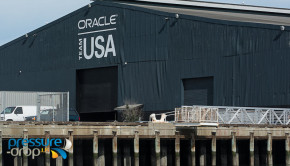International Moth – The Roller Coaster Life of a Development Class
Published on December 1st, 2010
 Part One – Wednesday, December 1, 2010
Part One – Wednesday, December 1, 2010
The International Moth class was on quite a roll by the time the 2009 Moth World Championship landed in Cascade Locks, Oregon. The virtues of foiling had gone viral. Awareness was epic, and interest was off the hook. This funny 11-foot singlehander rooted in the late 20’s was the talk of the sport.
The International Moth is a development class, which had always meant you needed to be as good in the garage as you were on the water. However, a lot has changed for the class since the foils. The introduction of productions boats brought in a new breed of sailors. But a production boat in a development class makes for odd bedfellows. And now the latest game changer may be discovered at the 2011 Worlds in Belmont, Australia (Jan. 8-14), where a number of boats will be powered by wing sails.
Here is a history update:
- Garage class gets pimped with foils. 2003/2004 in Perth, Australia.
- Everybody is amazed. Demand builds.
- Demand encourages concept of production version.
- Bladerider presents first mass produced version in 2006.
- Major class growth at Worlds. From 32 entries in 2006 to 95 in 2008.
- Production concept opens eyes to other builders.
- Drama at Bladerider. Designer leaves to market his own boat (Mach 2).
- Mach 2 emerges as better production option and dominates 2010 Worlds.
- Bladeriders are now off the pace. U.S. importer stuck with inventory.
- Wings emerge in 2010. Could soft sails be the next casualty?
Such is the roller coaster life of a class with rules that begin by saying, “The International Moth is a single-handed development class boat. The intention of these class rules is to give the designer and builder the fullest liberty in design and construction, within these rules to develop and produce faster boats.” As long as your boat fits within the length, width, and sail area limits, it’s a Moth.
Part Two – Thursday, December 2, 2010
Rohan Veal from Australia electrified the sailing world in 2005 when he became the first person to win an International Moth World Championship on hydrofoils, taking first place in eight straight races. For a class rooted in development, this was a game changer. Interest in the class has been sky high ever since, and now possibly faces its next game changer: a wing sail. We have seen them in the Little America’s Cup on the C Class catamarans, and earlier this year on the U.S. entry that defeated the Swiss in the 33rd America’s Cup. But now the Moth? Explaining this new reality is American Bora Gulari, 2009 Moth World Champion:
- What made you think a wing on the Moth was realistic?
 The Moth class is open and has always been an experimental class. When the foils were introduced to the class they were far more out in left field. Let’s not forget, wings have been around for 30+ years. After seeing BMW Oracle pooch the start of the first race of the America’s Cup in February, but then sail up, over and around Alinghi, we all wanted one at that very moment!
The Moth class is open and has always been an experimental class. When the foils were introduced to the class they were far more out in left field. Let’s not forget, wings have been around for 30+ years. After seeing BMW Oracle pooch the start of the first race of the America’s Cup in February, but then sail up, over and around Alinghi, we all wanted one at that very moment!
- Who have you collaborated with to develop your rig?
We have quite the wing team! It was designed by Canadians Steve Killing and Magnus Clarke, and built by Rob Paterson and Rossi Milev at Object 2 Skiffworks in Toronto with a bit of help from George Peet, Anthony Kotoun, Chris Rast and Andrew McCorquodale. This was Fred Eaton’s Little America’s Cup winning combo of designers and builders. He got it right so we copied!
- Is the wing destined to be a game changer for the class?
Time will tell, but there is nothing to be afraid of! Believe it or not, it is easier to rig, derig and easier to sail. If a wing is going to work in any class besides the C Class it would be the Moth.
- How has the class been dealing with the wing?
There is no current rule that addresses the wing. In August, the International Moth Class Association (IMCA) published an interpretation of the current class rules and their application to solid wing sails. More recently, the IMCA presented some questions about our wing design, to which we just submitted a response. The IMCA Executive Committee is working hard to make sure the road is clear for the 2011 Worlds in Belmont, Australia (Jan. 8-14).
- Seems like this wing project could be a huge distraction for you at the Worlds.
Maybe, but the class ethos is to develop and produce faster boats within the rules. This is what I believe we have done, and I gain as much satisfaction in this aspect of the class as I do competing on the water.
- How is sailing with the wing versus the soft sail?
 Quite a bit different. At first it was very complex with so many options for wing set up, and unlike the C Cats, we only have one set of hands onboard! It was initially a little stiff but we loosened it up a bit and have progressed from there!
Quite a bit different. At first it was very complex with so many options for wing set up, and unlike the C Cats, we only have one set of hands onboard! It was initially a little stiff but we loosened it up a bit and have progressed from there!
- Have there been spies?
In October there was a guy in a fishing boat with no fishing gear sitting in front of our sailing area with a big freaking camera.
- What has surprised you about sailing with the wing?
The one funny thing was how hiking is quite a bit different with the low sheet load. Your body is not being torqued as much, but at the same time your abs have to support more of your weight.
- Can you estimate what the cost difference is between soft sail and rig compared to wing sail?
Not at this point. The guys here at Object 2 Skiffworks are the premier wing guys. If you want a wing, you go to them. They have built eight wings, six in the last year, and had a heavy hand in the Oracle BMW wing.
- What about portability? It is so sweet how the Moth can fit into an airline style travel box. Can the wing fit into the box?
No but it is not far off the standard Mach 2 travel box.
- For your sake, we hope you get a chance to test the wing at the Worlds.
I hope so too. Thanks!
Acknowledging that it takes a pretty amazing person to order a Moth via the internet from an Australian company (Mach 2) that builds its boats in China, new North American Mach2 Distributors – Chris Rast and Anthony Kotoun – have gotten involved as dealers to help demystify the boat and the tuning process for the everyday sailor. Click here for support.









 We’ll keep your information safe.
We’ll keep your information safe.